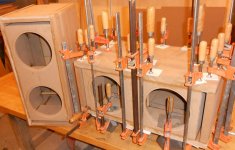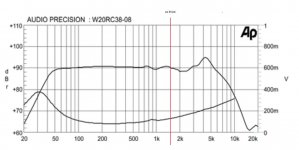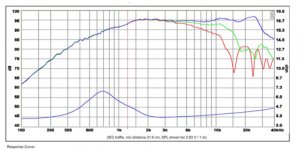What Wesayo is saying.
Look up Snell's XA Reference. Basically, you need a smaller MM between your 8" and a tweeter.
Look up Snell's XA Reference. Basically, you need a smaller MM between your 8" and a tweeter.
FWIW, the Behringer 8" plus tweeter active monitors (B2031A) that received rather good reviews from Linkwitz and others have a woofer-tweeter centre to centre of about 19cm, which is a wavelength of ~1.8kHz. The crossover is around 2.5kHz for the passive ones, 2kHz for the active ones.
Some info about it here...
Zaph|Audio - you'll need to do a Ctrl+F to find the speakers. Zaph's reviewed the passive version, so pulls the individual drivers, does off-axis measurements, the lot.
I've got a pair of them, and find them more enjoyable than my previous system, mostly because I can turn them up and they'll stay clean. They also sound annoyingly good, given how many rules they seem to break.
I'd consider knocking together a replacable baffle, have one symmetrical, one with the closest woofer centre-to-centre distance, see what's what.
Chris
Some info about it here...
Zaph|Audio - you'll need to do a Ctrl+F to find the speakers. Zaph's reviewed the passive version, so pulls the individual drivers, does off-axis measurements, the lot.
I've got a pair of them, and find them more enjoyable than my previous system, mostly because I can turn them up and they'll stay clean. They also sound annoyingly good, given how many rules they seem to break.
I'd consider knocking together a replacable baffle, have one symmetrical, one with the closest woofer centre-to-centre distance, see what's what.
Chris
Chris thanks... I'll check that out on Zaph's site.
May have posted this a long time ago...have you ever heard these?
http://www.qscaudio.com/products/speakers/k_series/K_series_K8.php
May have posted this a long time ago...have you ever heard these?
http://www.qscaudio.com/products/speakers/k_series/K_series_K8.php
Last edited:
I haven't knowingly heard those, though they also appear to abandon the idea of closest centre-to-centre in favour of a waveguide.
The bigger waveguides seem to boost the low end, so perhaps its a power handling tradeoff...
The bigger waveguides seem to boost the low end, so perhaps its a power handling tradeoff...
ODougbo, that's not the optimum solution because the distance between the two woofers is too large at the crossover. For example, if you cross them at 2 kHz to the tweeter, both woofers are radiating 2 kHz and they are too far apart. Around 2 kHz, the ear's sensitivity is highest, and it is also the region where we perceive direction of sound. In an MTM, it's not just the distance to the tweeter, it's the distance between the two Ms.
ODougbo, that's not the optimum solution because the distance between the two woofers is too large at the crossover. For example, if you cross them at 2 kHz to the tweeter, both woofers are radiating 2 kHz and they are too far apart. Around 2 kHz, the ear's sensitivity is highest, and it is also the region where we perceive direction of sound. In an MTM, it's not just the distance to the tweeter, it's the distance between the two Ms.
Again I'll reference the Jeff B mtm, where the woofers are further apart then the OP's mtm. A mtm is a set of compromises like any other design, doesn't mean it cant be made to sound good.
Could you post a link to that design? I'd be surprised if he used an 8" in an MTM crossed that high.
Could you post a link to that design? I'd be surprised if he used an 8" in an MTM crossed that high.
It is not a 8" mtm, it's a standard 7" mtm with a large faceplate tweeter. Center to center is greater then 11". It's linked in post #14.
MTM's have NEVER fallen within the wavelength requirements people around here try to say is needed....
Last edited:
Impressive indeed. He mentions about crossing low in order to avoid lobing. I don't know. I have my doubts even with a 7" woofer. If it were me, I'd do it like Wesayo showed.
There will be vertical lobbing, that is part of the original reason for a mtm design, control floor/ceiling reflections. The lobbing is not present on the horizontal plane, therefore only being an issue in certain situations.
CTC spacing isn't one of those "problems" that's easily heard. It's just a matter of improvement. Wide CTC spacing is rarely objectionable. But there is something to it IMO.
On the other hand, a 2.5 way is a great way to do MTM cause the tweeter / woofer interaction creates some vertical directivity that unites well with the second woofer as it kicks in as frequency decreases. Then the vertical directivity is more uniform and wider rather than a very narrow lobe right at the xo.
On the other hand, a 2.5 way is a great way to do MTM cause the tweeter / woofer interaction creates some vertical directivity that unites well with the second woofer as it kicks in as frequency decreases. Then the vertical directivity is more uniform and wider rather than a very narrow lobe right at the xo.
CTC spacing?
Checked tuning, the sim was correct, "wings" are 5-3/4" from front edge.
I used volt meter, load resistor, etc. I think of the three points as a triangle; this looked good, both of the high swings were equal, valley 50hz-52hz.
(somebody may have to interpret 😱)
The bass is nice and strong to 55hz-60hz, a noticeable dip around 50hz.
The woofers are pretty darn smooth; they do not push a lot of air.
Checked tuning, the sim was correct, "wings" are 5-3/4" from front edge.
I used volt meter, load resistor, etc. I think of the three points as a triangle; this looked good, both of the high swings were equal, valley 50hz-52hz.
(somebody may have to interpret 😱)
The bass is nice and strong to 55hz-60hz, a noticeable dip around 50hz.
The woofers are pretty darn smooth; they do not push a lot of air.
Attachments
I have a small twist to the 2.5 "helper woofer" approach that provides the additional benefit of smoothing self-interference notches from nearest boundaries.
The idea is to put the helper woofer in a second enclosure flanking the mains. Put the main speaker on a stand, and the flanking woofer beside, below and behind it. This makes the path length between the listener and the main woofer different than the distance to the flanking woofer, so notches from nearest boundaries - usually the floor and the wall behind the speakers - are at different frequencies for each source. Where one source is notched out, the other isn't. So what would be a 15-20dB notch from a single source is reduced to a 6dB notch using the flanking sub approach.
The idea is to put the helper woofer in a second enclosure flanking the mains. Put the main speaker on a stand, and the flanking woofer beside, below and behind it. This makes the path length between the listener and the main woofer different than the distance to the flanking woofer, so notches from nearest boundaries - usually the floor and the wall behind the speakers - are at different frequencies for each source. Where one source is notched out, the other isn't. So what would be a 15-20dB notch from a single source is reduced to a 6dB notch using the flanking sub approach.
I'm pretty sure the OP would be running the 0.5 woofer to high for that approach and screw up the midrange. It would also negate the idea of continuing the vertical directivity as the helper woofer comes on board.
Why is this so difficult? Dumb question? I've been an MTMr since the 80s when I saw the primordial Meridian and bought the concept. So we return to psychoacoustics, which is to say that we listen to our beliefs. It should work, I built it, it does work. I spent time or money on it, so be it.
This started a few months ago when first started looking into MTM's - the first set had some highlights but strange phasing issues.
This project is fresh start, new tweeter and placed drivers as close as possible; ports are also on top and bottom. vs. the side ports (other project).
This project is fresh start, new tweeter and placed drivers as close as possible; ports are also on top and bottom. vs. the side ports (other project).
Can agree with the bass response here - that was obvious.
I saw some small plastic flare ports, that might have worked nicely, but just don't think they will ever have low bass (but we'll see soon).
If they do have some 😱 I could work some flare ports into the top/bottom vs. slots.
Thinking 1600-1700hz is a good xo point.
I saw some small plastic flare ports, that might have worked nicely, but just don't think they will ever have low bass (but we'll see soon).
If they do have some 😱 I could work some flare ports into the top/bottom vs. slots.
Thinking 1600-1700hz is a good xo point.
Attachments
Last edited:
- Status
- Not open for further replies.
- Home
- Loudspeakers
- Multi-Way
- 8" Woofer MTM - Trainwreck?




